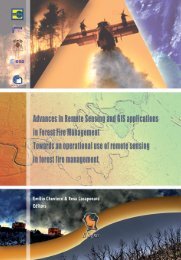Mapping microphytobenthos in the intertidal zone of Northern ...
Mapping microphytobenthos in the intertidal zone of Northern ...
Mapping microphytobenthos in the intertidal zone of Northern ...
Create successful ePaper yourself
Turn your PDF publications into a flip-book with our unique Google optimized e-Paper software.
Result<strong>in</strong>g Chl a maps (Figure 6) appear qualitatively correct but <strong>the</strong> retrieved concentration range seems to show an<br />
overestimation <strong>of</strong> Chl a based on our knowledge <strong>of</strong> <strong>the</strong> area. Unfortunately, it was impossible to validate <strong>the</strong>se<br />
concentrations because field samples collected at <strong>the</strong> time <strong>of</strong> <strong>the</strong> overflight were not properly frozen, prevent<strong>in</strong>g an<br />
accurate estimate <strong>of</strong> Chl a concentration.<br />
Figure 6. Chlorophyll a surface concentration maps derived from CASI data: a – “false color composite” (red: 865 nm; green:<br />
673 nm; blue: 489 nm); b – simple band ratio; c – normalized ratio; d – scaled band area.<br />
3.2.2. ROSIS<br />
As shown <strong>in</strong> Figure 7, regressions show a better fit than for CASI data. This is probably due to <strong>the</strong> fact that ROSIS<br />
spectral resolution is closer to field spectra resolution. All three approaches appear aga<strong>in</strong> equally robust (R 2 = 0.86).<br />
When applied to ROSIS images (Figure 8), as for CASI maps, Chl a spatial distribution is qualitatively correct but<br />
<strong>the</strong> concentration range is narrower.<br />
Validation through comparison with field samples (Table 2) shows a strong underestimation <strong>of</strong> Chl a concentration.<br />
This discrepancy could be expla<strong>in</strong>ed <strong>in</strong> part by <strong>the</strong> noise <strong>in</strong> <strong>the</strong> data, assumption which seems to be confirmed by<br />
<strong>the</strong> fact that <strong>the</strong> Scaled Band Area gives better results than <strong>the</strong> o<strong>the</strong>r approaches. Instrument calibration can also be<br />
404
















